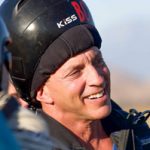The tenth chapter in Dan BC’s 4-way manual… Speed, Efficiency, Awareness, Communication, Synchronicity

The best formation skydiving teams balance several qualities. They fly fast but smooth. They are calm yet aggressive. They do the smallest, most efficient move as quickly as possible. And they do all this while staying perfectly in synch with each other.
Their jumps are totally under control and nothing happens by surprise. The team appears to move not as individuals but as four parts of one machine. This requires a combination of highly developed INDIVIDUAL FLYING SKILLS as well as TEAM FREEFALL COMMUNICATION SKILLS. Advanced individual skills enable each flyer to perform fast, precise solo movements. Advanced team communication skills synchronize the individual teammate’s movements. They are the glue that holds the individuals together and what enables the team as a whole, to fly at the full potential of the individual’s speed.
Team communication skills are the glue that holds the individuals together”
INDIVIDUAL FLYING SKILLS
The physical skills are generally the more simple (not to be confused with easy) part of competitive athletic training. The specific skills needed for success are obvious as are the proven methods and drills for which to train them. Excelling at these skills requires a deep commitment and hours of hard work and repetition. But almost anyone can do it if they believe they can and if they are willing to put in the hard work.
Almost anyone can do it if they believe they can and if they are willing to put in the hard work”
FLYING SKILLS
The individual flying skills of formation skydiving include the ability to:
- Move horizontally forward, backward and sideways.
- Turn in place by rotating around your center or other pivot points.
- Control your fall rate to maintain or adjust levels as needed.
- Execute moves where you combine horizontal, rotational and possibly vertical movements at the same time.
- Finish your move by coming to a complete, sharp stop and parking in position.
- Be solid in your position without allowing yourself to be moved.
- Maintain that position whether facing towards, away or sideways to the center of the formation.
- Maintain position while quickly picking up solid grips.
- Maintain position while releasing the grips with big hand movements used to show the judges that the entire team if off of the grips “flashing”.
There is no question that the best way to learn, and continue to sharpen your personal flying skills is in a wind tunnel. Training in a tunnel provides the extended freefall time we need to explore and discover the exact body position and body mechanics that are most effective for us.
There is no question that the best way to learn, and continue to sharpen your personal flying skills is in a wind tunnel”
Ultimately we want these movements to become muscle memory. Flying in a tunnel gives us the chance to do extensive repetitions and in doing so build that muscle memory in the shortest amount of time possible.
Soon after assembling your team you should arrange a tunnel camp with a qualified coach. Holding a two or three day tunnel camp early in your team’s training could save you two or three weeks down the road. It will allow you to learn the basics of correct body mechanics and begin to develop muscle memory that you will be able to build from.

BASIC NEUTRAL BODY POSITION
The first step to developing your individual flying skills is learning to fly in a comfortable neutral body position. By neutral I mean the body position you are in when you are sitting still. The position you return to after stopping a move.
There is no single basic neutral body position that is perfect for everyone. Varying heights, weights, builds and degrees of flexibility will all have an effect on what the exact body position is that works best for each individual.
Good Body Position Desirables
There are however certain characteristics that are common parts of all correct neutral body positions. They are:
- Your pelvis/lower abdomen area is the lowest point on the wind. It serves as your center of gravity providing a natural pivot point for in-place turns.
- Your head and eyes are the highest point. This allows for maximum visibility and awareness of the entire team.
- An unforced pelvis low, head high position is the definition of a comfortable arch. From this configuration you should be in the middle of your fall rate range. Quick level changes and recovery are easy and can be done with minimal body movements.
- Your legs are comfortably spread at roughly between a 45 and 90 degree angle. This provides a strong, stable stance on the air and a larger flying surface.
- The angle between your arms and torso is 90 degrees or slightly more. This keeps your hands forward and in a position that requires minimal movement when picking up and dropping grips.
- Your arms are lower than your eyes and head. This prevents them from blocking your line of sight and keeps your hands level with your teammates’ grips.
A reasonably flexible person, flying alone and relaxing on the air will naturally assume a neutral position similar to what is described here. (Individuals with extreme or limited flexibility will have to work a little harder.) In this position you feel solid and are very balanced on the air. You are in the middle of your range of motion and have access to the full capabilities of all your flying surfaces.

FALL RATE
The most common cause for compromising this body position comes from fighting the fall rate. In competition Formation Skydiving being able to “stay up” or “stay down” with your team’s fall rate is not enough. It is crucial that everyone on the team effortlessly stays on level while flying in their neutral position.
If you are not able to easily maintain levels while in your neutral position than you, and perhaps the entire team, will have to adjust the fall rate. Ideally a team is well enough matched in their physical size, build and shape that they can use tight competition suits and go without additional weights. But this is rarely the case. On most teams each individual has to contribute to creating the team’s perfect fall rate. This may involve gaining, losing or wearing weights, increasing your flexibility through extra stretching exercises or using a bigger suit.
There are limits to how much weight a person can gain or lose without sacrificing their personal physical conditioning. But nearly everyone can adjust 5 or 10 pounds and quite often, that’s all it takes.

Dan Brodsky-Chenfeld and Kirk Verner
When we started Airspeed everyone on the team was in reasonable physical condition. But all of us except for Kirk were wearing weights. We set the goal of adjusting our physical training to bring our personal body weights to a place where none of us needed a weight vest. We all gained or lost up to 15 pounds, increased our flexibility, improved our conditioning and became leaner and stronger in the process. Two months later none of us were wearing weights and we were all in far better shape.
Not all teams are similar enough in size and shape to do this. But a lot of extra material on a jump suit or excessive amount of weight in a vest will ultimately limit your ability to fly at your full potential. As much as possible should be done to adjust your own weight with diet and good physical conditioning before giving in to only relying on equipment modifications.
You will always continue to work towards perfecting your personal flying skills. But you can’t wait for them to be perfect before beginning to train as a team. As soon as your individual flying skills are fairly competent you should begin your team training.

TEAM FREEFALL COMMUNICATION SKILLS
Members of world class formation skydiving teams have trained all of their personal flying skills to the point that they are muscle memory. But even four great individual skydivers at a world class level will not necessarily skydive as a world class team.
For a team to actually perform up to the full potential of the individual teammates’ flying skills they must first develop sharp, clear and understandable freefall communication skills. It is these skills that will enable the team to fly at their maximum speed while also minimizing and synchronizing their moves. A team with good freefall communication knows when they can add speed or when they need to pause and regain control. They appear to be glitch-free, moving as if they were four parts of one machine. For a team without this skill even the smallest glitch can lead to a costly breakdown and opportunities for the team to accelerate will slip by unnoticed.
At the core of this communication is laser vision eye contact. Not just looking at each other but actually talking to each other with your eyes. You must create a level of eye contact and communication that enables you to read each other’s mood, thoughts, intensity and intent. With this heightened communication the team will be able to read the play and make instant decisions during the jump on how best to maximize the potential of each moment.

TEAM FREEFALL COMMUNICATION SKILLS
- Focused eye contact.
- Awareness of everything that is happening with the entire team.
- Awareness of the entire team’s physical, mental and emotional condition.
- Reading each others’ thoughts and intent through focused eye contact.
- Communicating readiness through solid grips.
- Seeing the jump is on target and going as planned or recognizing unexpected errors.
- The ability to make fully understood and well communicated decisions instantly.
- Anticipation. Knowing the next formation BEFORE the formation you are building is complete.
- Recognizing the team’s readiness and pushing the key speed accordingly.
- Key discipline, seeing the keys and following the key person.
- Synchronizing movements, as well as taking and breaking grips.
Most teams make the mistake of focusing on their personal flying and neglecting their communication skills. Your team will never be as good as the individuals on it if you make the same mistake. The first thing you need to do in your actual jumping training is to turn four individual skydivers into a team by training your in air communication.
More Magic From Dan
Previous Article (9): Understanding the Game
Next Article (11): Understanding the Different Slots
Above All Else

Several articles in this series are extracts from Dan’s amazing book, ‘Above All Else’, which covers far more than skydiving. It’s available from Square One HERE or Amazon HERE, where you can check the glowing reviews, mostly from non skydivers, such as:
“I can’t recommend the book more. Do yourself this favor and just read it. Sure, it’s not Shakespeare, but it’s truth. At 120 MPH. And you will be forever changed.”
Amazon review by Esta Desa


